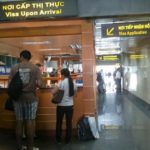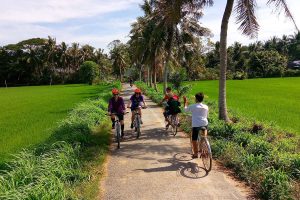Planning a short but memorable escape to Vietnam’s largest island requires careful consideration to maximize your time. This guide provides a detailed 4 Days in Phu Quoc Itinerary, designed to balance relaxation on beautiful beaches with engaging cultural experiences and adventurous exploration across the island’s diverse landscapes. From arrival logistics to packing tips and navigating the island, this comprehensive plan equips you to make the most of your 4-day trip to Phu Quoc.
How to Get to Phu Quoc Island, Vietnam
Reaching the tropical paradise of Phu Quoc is relatively straightforward, whether you’re coming from within Vietnam or internationally. The island is well-connected by air and sea, offering different travel experiences depending on your starting point and preference for speed versus scenic journey. Understanding the options helps you choose the best approach for your specific trip constraints and desired arrival experience.
Flying into Phu Quoc
The most common and fastest way to reach Phu Quoc is by air, landing at Phu Quoc International Airport (PQC). This modern airport handles both domestic and international flights, connecting the island to major cities in Vietnam like Ho Chi Minh City (Saigon), Hanoi, Da Nang, Hai Phong, Can Tho, and Rach Gia, as well as a growing number of international destinations, though most international travelers connect through Vietnamese hubs.
Flying from Ho Chi Minh City or Hanoi is the most popular route for visitors. Flights from Ho Chi Minh City are frequent, taking just under an hour, making it an ideal quick hop. Services are offered by several major airlines, including Vietnam Airlines, VietJet Air, and Bamboo Airways, providing competitive pricing and convenient schedules throughout the day. Flights from Hanoi are longer, around two hours, but are also plentiful and cater to travelers starting their Vietnam journey in the north. Booking in advance, especially during peak season (roughly November to April), is highly recommended to secure better fares and preferred timings. Checking aggregator sites alongside individual airline websites can help compare prices effectively. The airport itself is located centrally, making transfers to most accommodations relatively quick and easy, typically taking 20-45 minutes depending on traffic and your final destination area on the island.
Beyond the transit time, consider the entire airport experience. Vietnamese domestic air travel is generally efficient, but like anywhere, delays can occur. Factor in time for check-in, security, and potential minor hold-ups. The airport in Phu Quoc is relatively small compared to major international hubs, which can make arrival and luggage collection faster, contributing to a smoother start to your 4 Days in Phu Quoc Itinerary. The feeling upon landing, seeing the tropical landscape spread out below, immediately sets the tone for a relaxing island getaway, a stark contrast to the hustle of the mainland cities.
Ferry Travel to Phu Quoc
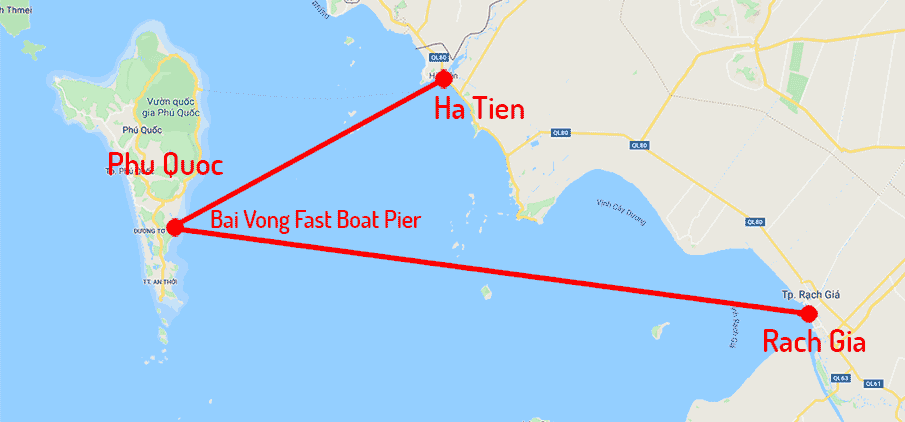
For a different pace and experience, traveling to Phu Quoc by ferry from the mainland ports of Ha Tien or Rach Gia is a compelling option, particularly for those already exploring the Mekong Delta region. Ha Tien is closer to Phu Quoc, with ferry journeys taking roughly 1 hour and 15 minutes via high-speed hydrofoil. Rach Gia is further away, and the journey takes around 2.5 to 3 hours.
High-speed ferries, operated by companies like Superdong or Phu Quoc Express, offer a comfortable and generally reliable service. These modern catamarans are air-conditioned and provide onboard seating, though the sea can be choppy at times, particularly during the rainy season (May to October), which might make flying a more comfortable choice for those prone to seasickness. The ferry terminals on the mainland are usually bustling, and arriving early to purchase tickets or having pre-booked online is advisable, especially during holidays. The journey itself offers scenic views as you cross the Gulf of Thailand, watching the mainland fade and the distant shape of Phu Quoc grow larger on the horizon. It provides a sense of transition, a slower pace that fits well with embracing the island’s laid-back vibe even before you arrive.
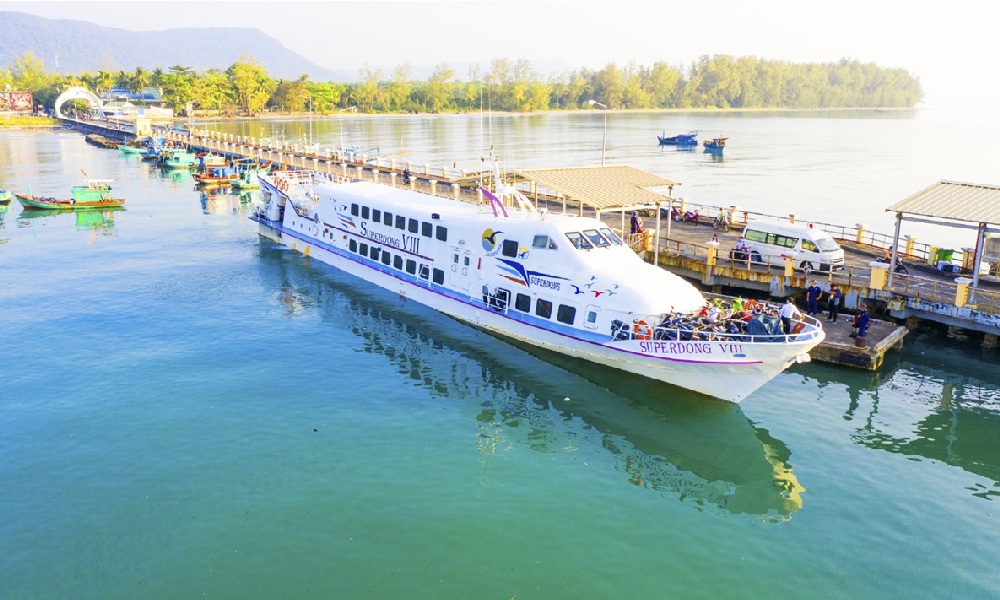
Ferry of Superdong from Rach Gia to Phu Quoc Island
Arriving at Bai Vong port on Phu Quoc’s east coast via ferry requires planning for your onward journey to your accommodation, as it’s further from the main tourist areas like Long Beach or Duong Dong town compared to the airport. Taxis and pre-booked transfers are readily available at the port, but it’s wise to have your transport arranged or a ride-sharing app ready. While flight delays can happen, ferry schedules are sometimes more susceptible to weather conditions, so always check for potential disruptions, particularly if traveling during the low season or a period of storms. Choosing the ferry adds an element of adventure and connects you more directly with the coastal feel of southern Vietnam before reaching the island itself.
Booking and Travel Considerations
Regardless of whether you fly or take the ferry, advance booking is crucial for securing the best prices and ensuring availability, especially during peak travel periods. Prices for flights can fluctuate significantly based on demand, time of year, and how far in advance you book. Setting price alerts or booking several months ahead for travel during peak season or major holidays is a smart strategy.
For ferries, while less volatile than flight prices, booking ahead online or through a local agent prevents disappointment, especially if traveling on a weekend or during Vietnamese public holidays when demand for tickets can be high. Consider the cost versus time trade-off: flying is more expensive but saves valuable travel time for your relatively short 4-day trip, maximizing your leisure time on the island. The ferry is cheaper but consumes a significant portion of a travel day, which might be a consideration for those on a tight schedule. Also, factor in luggage allowances – airlines have stricter limits, while ferries are generally more lenient with bulkier items, which could be relevant if you’re traveling with extensive gear.
Finally, be aware of visas and entry requirements for Vietnam. Most nationalities require a visa, which can be obtained through an embassy, e-visa, or visa on arrival (under specific conditions). Phu Quoc has a special economic zone status, allowing certain nationalities to enter visa-free for up to 30 days. However, this typically requires flying directly into Phu Quoc or arriving via a land/sea border and proceeding directly to Phu Quoc without stopping elsewhere in Vietnam first. Always double-check the latest visa regulations specifically for Phu Quoc based on your nationality and intended travel route before booking, as navigating entry rules is a fundamental step to ensure a smooth start to your tropical island adventure.
How to get Around Phu Quoc Island?
Navigating Phu Quoc offers a mix of options, each with its own advantages and considerations regarding cost, convenience, and the level of immersion in the local environment. The right choice depends on your budget, comfort level with various modes of transport, and how much you plan to explore beyond your immediate resort area during your 4 Days in Phu Quoc Itinerary. The island’s infrastructure varies from paved main roads to rugged dirt paths, influencing which transport methods are most effective in different areas.
Renting a Scooter
Renting a scooter or motorbike is arguably the most popular way for independent travelers to get around Phu Quoc. It offers unparalleled freedom and flexibility, allowing you to explore hidden beaches, winding coastal roads, and rural areas at your own pace. Rental shops are ubiquitous, especially in Duong Dong town and around major tourist areas like Long Beach, and prices are relatively affordable, typically ranging from 120,000 to 200,000 VND per day depending on the scooter model and rental duration.
The process is usually simple, involving presenting your passport (sometimes they hold it, which is common but carries a small risk; sometimes a copy or deposit is sufficient) and signing a basic rental agreement. Scooters are generally well-maintained but always inspect the bike before riding – check the brakes, tires, lights, horn, and fuel gauge. It’s crucial to note that legally, you need a valid Vietnamese driving license or an International Driving Permit (IDP) that is recognized in Vietnam (specifically, one that follows the 1968 Vienna Convention is best, along with your home country license). While enforcement varies and many tourists ride without the proper license, doing so invalidates most travel insurance in case of an accident and could lead to fines or difficulties with authorities if stopped. Vietnamese traffic can be chaotic, especially in towns, so confidence and caution are essential. Helmets are mandatory and usually provided with the rental – always wear one and ensure it fits correctly.
Riding a scooter provides a sensory connection to the island; you feel the warm air, smell the tropical flowers or sea breeze, and hear the daily sounds of local life passing by. It allows spontaneous stops at roadside food stalls, local markets, or stunning viewpoints that you might miss in a closed vehicle. However, it requires attention to road conditions, which can be poor and pot-holed, especially on lesser-traveled routes. Night riding can be particularly challenging due to limited street lighting outside of main areas and unpredictable obstacles. It’s a fantastic way to experience Phu Quoc intimately, but it’s not for the faint of heart or inexperienced riders. The sense of adventure and independence it offers is a significant draw, making it a core part of many visitors’ exploration strategy.
Taxis and Ride-Sharing Services
Taxis are readily available throughout the main tourist areas, offering a convenient and comfortable option, especially if you’re traveling in a group, with luggage, or prefer not to navigate traffic yourself. Major taxi companies include Mai Linh (green taxis) and Vinasun (white taxis, though less common on Phu Quoc than the mainland), which are generally reputable and use meters. It’s always best to insist the driver uses the meter or agree on a fixed price before starting the journey to avoid potential overcharging, although meter usage is standard practice with these companies.
Ride-sharing services like Grab are also operational on Phu Quoc, offering both GrabBike (motorbike taxis) and GrabCar (car taxis). Using the Grab app allows you to see the fare upfront, track your driver, and pay electronically, adding a layer of transparency and security that many travelers appreciate. Availability might be higher in Duong Dong and along Long Beach compared to more remote parts of the island, particularly late at night. GrabBike is an even more cost-effective way to cover shorter distances or navigate through traffic quickly if traveling solo and comfortable riding pillion on a motorbike.
Choosing taxis or Grab provides a stress-free way to travel between specific points, such as getting from your resort to a restaurant in town or transferring from the airport without the hassle of navigating or parking. While more expensive than renting a scooter for extensive exploration, it offers safety and convenience, especially after dark or during inclement weather. For specific activities, like visiting the Vinpearl area or going on a fishing/snorkeling trip, many tours include transportation, reducing the need for independent transport on those particular days, allowing you to mix and match transport modes during your 4 Days in Phu Quoc Itinerary. The ease of simply stepping out and hailing a taxi or booking a Grab means less time spent on logistics and more time enjoying the island.
Private Transfers and Tours
For maximum convenience, particularly for families or groups or for transferring to and from the airport or ferry port, arranging private transfers is an excellent option. Many hotels and resorts can organize airport pickups and drop-offs, sometimes included in the room rate or for an additional fee. Alternatively, you can book private cars and drivers through local tour operators or online platforms. While the most expensive transport option, a private car offers comfort, reliability, and the ability to travel directly to your destination without stops. It’s especially useful if you have a significant amount of luggage or value privacy.
Furthermore, participating in organized tours often includes transportation. Booking a snorkeling trip, a tour to the An Thoi islands, a visit to Vinpearl Land, or a guided exploration of the North Island typically includes bus or van transfers from your accommodation. This removes the complexity of figuring out transport to potentially distant or hard-to-reach attractions, allowing you to relax and focus on the experience. Tours can be a very efficient way to see multiple sights in a single day without the stress of navigating unfamiliar roads or arranging multiple taxi rides.
Combining these transport methods is often the most effective strategy for a 4-day trip. Perhaps rent a scooter for a day or two to explore nearby beaches and experience the freedom, use taxis or Grab for evening meals or specific transfers, and book a tour for island hopping or visiting major attractions in the north or south. This flexible approach ensures you can access all parts of the island comfortably and safely, tailoring your movement to the day’s activities and your personal preferences. Understanding the strengths of each option allows you to build a seamless 4 Days in Phu Quoc Itinerary.
Where to Stay in Phu Quoc?
Selecting the right base for your 4 Days in Phu Quoc Itinerary is crucial to shaping your experience. Phu Quoc offers a diverse range of accommodation options spread across different areas of the island, each with its own unique atmosphere, proximity to attractions, and type of beaches. From bustling central locations to secluded beachfront bungalows, your choice of where to stay will significantly impact the pace and focus of your trip.
The primary areas for accommodation cluster along the west coast, with pockets of resorts and guesthouses in the north and south. The style varies widely, encompassing everything from luxury international resorts chains with extensive facilities to charming boutique hotels, budget-friendly guesthouses, and rustic beachfront bungalows. Deciding on your priorities – whether it’s easy access to restaurants and shops, a quiet stretch of sand, or proximity to specific attractions – will guide you to the ideal location.
West Coast: Long Beach and Duong Dong
Long Beach (Bai Truong) is the most developed and popular area for tourists on Phu Quoc, stretching for many kilometers south from the main town of Duong Dong. This area offers the widest selection of accommodation, ranging from large resorts with extensive pools and amenities to smaller hotels and guesthouses set a short walk back from the beach. Staying along Long Beach or just inland provides easy access to a vast number of restaurants, bars, shops, spas, and tour operators, particularly as you get closer to Duong Dong.
The beach itself is known for its stunning sunsets, wide expanse of sand (though the quality can vary), and calm waters during the dry season. It’s an ideal base for those who value convenience, variety in dining and entertainment options within walking distance or a short taxi ride, and being close to the administrative and commercial center of the island, Duong Dong. Duong Dong offers a vibrant local market, the Dinh Cau Temple viewpoint, and numerous seafood restaurants along the river and coast. Staying here or nearby means you’re never far from the action and amenities.
However, the popularity of Long Beach also means it can feel more crowded and less tranquil than other parts of the island, especially during peak season. Some sections of the beach facing the main resorts can be busy with sunbathers and water sports. Traffic on the main road (Tran Hung Dao) parallel to the beach can also be heavy. Despite the crowds, the sheer variety of accommodation and easy access to everything makes it a practical choice for many visitors, providing a comfortable and convenient hub from which to launch your exploration of the island during your 4 Days in Phu Quoc Itinerary. It’s perfect if you want everything within easy reach and don’t mind being in the heart of the tourist area.
North and East Coasts: Serenity and Local Life
For travelers seeking a quieter, more relaxed atmosphere, the north and east coasts offer appealing alternatives. The area around Ong Lang Beach, just north of Duong Dong on the west coast but significantly less developed than Long Beach, provides a beautiful compromise. Ong Lang features a sequence of lovely, often quieter beaches and bays, with a growing number of charming boutique resorts, villas, and guesthouses nestled among the trees.
This area retains a more laid-back, village-like feel. While there are restaurants and shops, they are more spread out and focus more on smaller, independent establishments. It’s ideal if you prioritize relaxation, peaceful beachfronts, and being closer to nature. Getting to Duong Dong or other parts of the island usually requires a scooter ride, taxi, or Grab, but the trade-off is a sense of tranquility and escaping the main tourist bustle. The beaches here are often pristine and less crowded, offering perfect spots for quiet contemplation, swimming, or simply enjoying the sun in peace.
Further north, towards areas like Ganh Dau, you’ll find larger, more secluded resorts, including the Vinpearl complex with its associated theme parks. This area is best suited for those who intend to spend most of their time within a resort bubble, perhaps with family enjoying the extensive facilities. It’s quite remote from Duong Dong and other island attractions, requiring significant travel time to explore elsewhere. The east coast, particularly around Ham Ninh fishing village, offers a glimpse into local life and stunning views back towards the mainland, but accommodation options are more limited to guesthouses and smaller hotels, often not directly on the main beaches. Choosing the north or east is about prioritizing peace, natural beauty, and a slightly more off-the-beaten-path experience, requiring you to be more intentional about planning transport for island exploration, but rewarding you with serene landscapes and authentic village atmospheres.
South Coast and Beyond: Islands and Seclusion
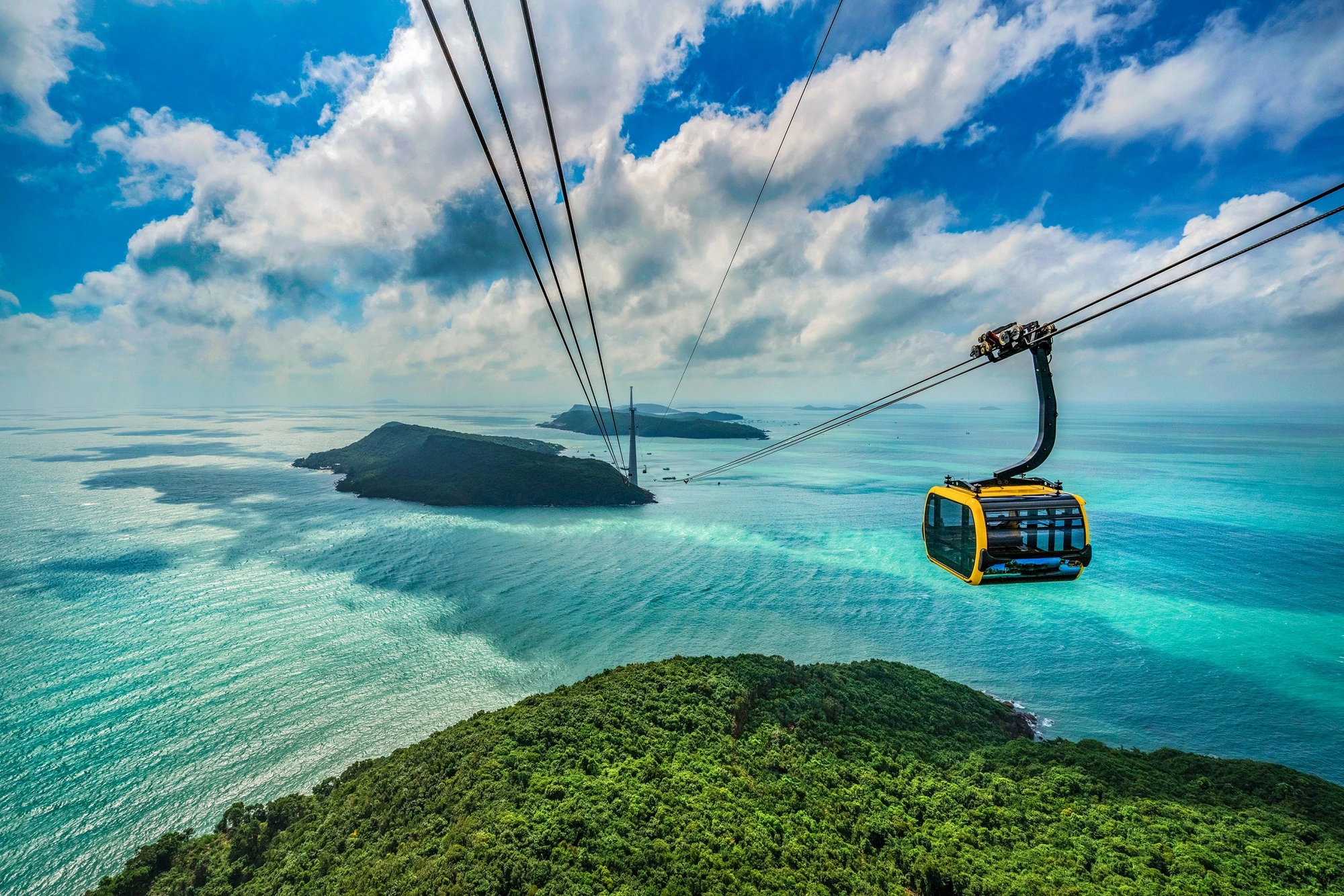
Hon Thom Cable Car
The south coast, especially around An Thoi town and further towards beaches like Bai Sao (Sao Beach) and Bai Khem (Khem Beach), presents another distinct lodging choice. An Thoi is the departure point for many island-hopping and snorkeling tours around the southern archipelago, making it a practical base if your primary focus is exploring the southern islands. Accommodation here includes local guesthouses, budget hotels, and some newer resorts.
Sao Beach is famous for its stunning white sand and turquoise waters, often cited as one of Vietnam’s most beautiful beaches. Staying near Sao Beach offers direct access to this postcard-perfect location. While development is increasing, it still feels less built-up than Long Beach, though facilities like restaurants and shops might be less varied, particularly outside of resorts. Khem Beach, once a military area, has seen significant luxury resort development and offers high-end, secluded stays.
Choosing the south means you’ll be closer to the cable car to Hon Thom island, the southern archipelago, and certain attractions like the Phu Quoc Prison historical site. However, it means you are further from Duong Dong and the northern part of the island, requiring longer travel times for activities in those areas. This area caters to those who are captivated by the southern islands and beaches, prioritizing stunning natural beauty and perhaps being willing to travel further for variety. It’s about embracing the iconic ‘paradise beach’ vision of Phu Quoc and having it right on your doorstep for a significant portion of your stay.
| Area | Vibe & Atmosphere | Beach Quality & Access | Proximity to Amenities & Attractions | Typical Accommodation Types | Best For |
|---|---|---|---|---|---|
| Long Beach/Duong Dong | Lively, convenient, main tourist hub | Wide, accessible, varying quality, good for sunsets | High: Many restaurants, shops, bars, tour operators, markets, airport (20-30 min) | Resorts (Luxury to Mid-range), Hotels, Guesthouses | First-time visitors, those valuing convenience, variety, and nightlife |
| Ong Lang | Laid-back, tranquil, village-like | Multiple beautiful, quieter bays, less crowded than Long Beach | Moderate: Growing number of restaurants/shops, requires transport for Duong Dong (10-15 min scooter/taxi) | Boutique resorts, Villas, Guesthouses | Those seeking relaxation, quieter beaches, charming atmosphere |
| North Coast | Secluded, family-focused (near Vinpearl) | Varies, some pristine bays, some resort-specific beaches | Low to Moderate: Limited options outside resorts/Vinpearl, far from Duong Dong (30-60+ min scooter/taxi) | Large resorts, Theme park hotels, some guesthouses further north | Families (near Vinpearl), those desiring seclusion or resort-focused trips |
| South Coast (Sao Beach/An Thoi) | Developing, gateway to islands, iconic beaches | Sao Beach: Stunning white sand/turquoise water (can be crowded); Khem Beach: High-end privacy; An Thoi: Port/less beach | Moderate: Closer to cable car, southern islands, prison. Far from Duong Dong (30-45 min scooter/taxi) | Resorts (Luxury to Mid-range), Guesthouses (An Thoi), Bungalows (Sao Beach) | Island hopping enthusiasts, those prioritizing famous beaches, seclusion (Khem) |
Ultimately, the best place to stay depends on your budget and how you envision spending your 4 Days in Phu Quoc. If exploration and variety are key, a central location like Long Beach or Ong Lang provides a good base. If peaceful relaxation on a perfect beach is paramount, areas like Ong Lang or near Sao Beach might be preferable. For families focusing on entertainment complexes, the north is suitable. Consider how much time you’re willing to spend traveling to and from different parts of the island when making your decision, as this significantly impacts the logistics of your 4 Days in Phu Quoc Itinerary.
Itinerary: 4 Days in Phu Quoc Island
A 4-day trip allows for a wonderful snapshot of Phu Quoc, blending iconic beach experiences with cultural insights and natural discoveries. This itinerary is designed to offer a balanced mix, allowing time for relaxation by the sea each day while exploring different facets of the island. From arriving and settling into your chosen beachside haven to exploring the vibrant town, venturing south for island adventures, or heading north for nature and culture, this plan maximizes your short time on the island, ensuring a comprehensive and enjoyable escape to paradise. This itinerary assumes you have chosen to base yourself near a beach, offering flexibility depending on your specific accommodation location, likely along the popular west coast (Long Beach, Ong Lang) for convenience, but adaptable for other areas. The key is to establish a comfortable rhythm that allows for both exploration and downtime.
Day 1: Arrival, Long Beach Sunset, and Duong Dong Charm
Your first day is about settling in, getting acquainted with the island’s relaxed pace, and experiencing one of its most famous evening rituals. After arriving at Phu Quoc International Airport (PQC) or Bai Vong ferry port, transfer to your accommodation. Take some time to check in, unpack, and decompress from your journey. Spend the afternoon relaxing on the beach closest to your hotel, whether it’s Long Beach, Ong Lang, or another coastal spot. Feel the sand between your toes, take a refreshing dip in the sea, or simply lounge by the pool. Allow the tropical atmosphere to wash over you and adjust to the island’s gentle rhythm.
As the late afternoon approaches, make your way to Long Beach for the iconic sunset. This west-facing stretch of coastline is renowned for its spectacular evening skies as the sun dips below the horizon, painting the clouds in vibrant hues of orange, pink, and purple. Find a beachfront bar or restaurant, order a refreshing drink – perhaps a local beer or a tropical fruit smoothie – and witness this daily natural spectacle. The atmosphere is typically lively but relaxed, with fellow travelers and locals gathering to enjoy the view. Many establishments set up tables and chairs directly on the sand, offering a perfect vantage point. This moment of watching the sunset over the ocean is the quintessential Phu Quoc welcome, setting a peaceful tone for the days ahead.
After sunset, head into Duong Dong town, the island’s main hub, located at the northern end of Long Beach. Explore the bustling night market (Dinh Cau Night Market), a vibrant sensory experience filled with stalls selling fresh seafood, local snacks, handicrafts, and souvenirs. This is an excellent place to sample a variety of local dishes, from grilled seafood skewers and crab soup to sweet treats and fresh fruit juices. Wander past Dinh Cau Temple, perched on a rocky outcrop overlooking the sea, beautifully lit up at night. The temple is not just a spiritual site but also a picturesque landmark and active harbor view. Dinner can be had at the night market for a casual, diverse experience, or at one of the many restaurants in town ranging from local eateries serving traditional Vietnamese cuisine to more international options. This first evening provides a perfect blend of beach relaxation, natural beauty, and local culture, grounding you in the island’s main area.
Day 2: Southern Island Delights – Snorkeling and Sao Beach
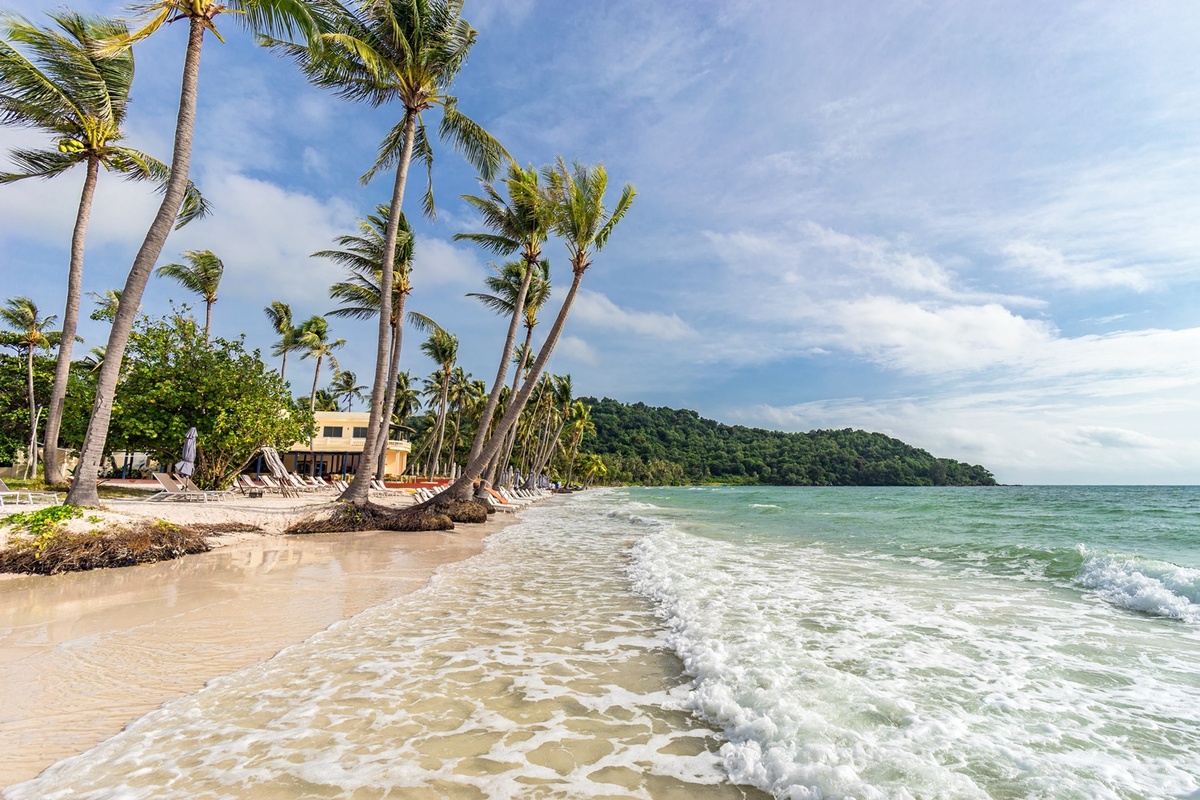
Sao Beach, Phu Quoc Island
Day 2 is dedicated to exploring the stunning southern tip of Phu Quoc and its surrounding archipelago, famous for vibrant coral reefs and pristine beaches. A popular way to experience this is by booking a boat trip from An Thoi port. These tours typically include snorkeling stops at various islets like Hon Roi, Hon Buom (Fingernail Island), and Hon Gam Ghi, where you can discover colorful marine life and coral gardens.
The boat journey itself is part of the adventure, offering scenic views of the coastline and the numerous small islands scattered in the Gulf of Thailand. Many tours also include activities like fishing (sometimes with hand lines, providing a rustic experience) and a simple but fresh lunch prepared on board, often featuring the morning’s catch. The quality of coral can vary, particularly near more frequented spots, but guides often know the better patches. Even for non-snorkelers, the boat ride and island stops offer beautiful scenery and a chance to swim in clear waters. Some tours may include a stop at a pearl farm near An Thoi or offer the option to ride the Hon Thom cable car, one of the world’s longest oversea cable car systems, connecting Phu Quoc to the island of Hon Thom (Pineapple Island), home to a large water park.
After the island hopping or as an alternative, head to Sao Beach (Bai Sao), located on the south-east coast. Often hailed as one of the most beautiful beaches in Vietnam, Sao Beach boasts soft white sand and calm, shallow turquoise waters, particularly during the dry season (around November to April). It’s an idyllic spot for sunbathing, swimming, or simply walking along the shore. While it can get busy, especially near the access points with restaurants and chair rentals, you can often find quieter stretches by walking further along the bay. Spend your afternoon here soaking up the sun and enjoying the picture-perfect tropical scenery. For dinner on Day 2, you might enjoy fresh seafood at a restaurant near Sao Beach, head back towards your accommodation area for more options, or discover local eateries in An Thoi if you opted to stay closer to the southern port. This day focuses on the natural allure of the south, offering opportunities for water activities and enjoying Vietnam’s most famous beach landscapes.
Day 3: Northern Exploration – Nature, Culture, and Local Life
On your thirdday, set off to explore the northern part of Phu Quoc Island, where stunning landscapes, local culture, and unique attractions await you. The north offers a different vibe from the bustling beaches of the south, allowing you to delve deeper into the island’s rich natural beauty and heritage.

Vinpearl Safari Phu Quoc
Vinpearl Safari and Resort Experience
One of the must-visit attractions in the northern region is the Vinpearl Safari, a large wildlife conservation area that allows visitors to observe various animals in environments that mimic their natural habitats. This park is home to over 3,000 animals from around the world, including African lions, white tigers, and exotic birds.
Spend your morning meandering through the safari grounds, where you can take a safari bus tour or walk along the paths. The experience is not only entertaining but educational, as many signs provide insights into the animals and conservation efforts. Children and adults alike will enjoy seeing these magnificent creatures up close.
Afterward, consider visiting the nearby Vinpearl Land Amusement Park for some thrilling rides or water activities. It includes an aquarium, a shopping street, and numerous dining options, making it a perfect family-friendly destination.
Tranquility at An Thoi Islands
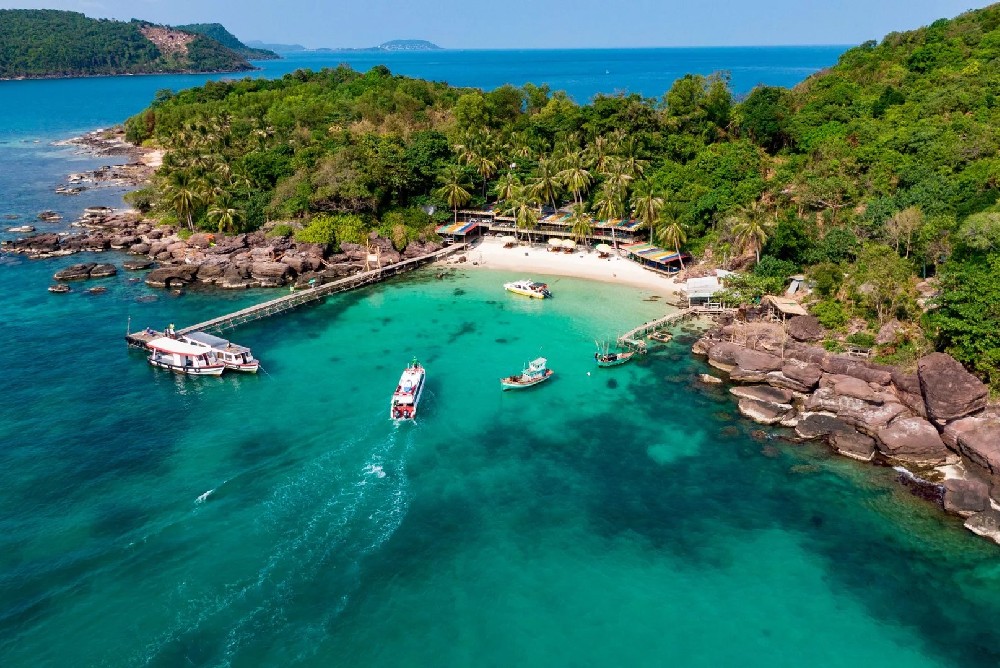
An Thoi Island
After the excitement of the safari, head to the An Thoi Archipelago, just south of the main island. This group of islands offers serene beaches and untouched nature, perfect for those looking to escape the crowds. You can book a boat tour that takes you around the islands, with stops for swimming, snorkeling, and relaxing on secluded beaches.
Each island has its own unique charm; for instance, Hon Thom boasts stunning coral reefs and picturesque landscapes. Here, you can snorkel among colorful fish or simply bask in the sun on pristine sands. If you’re feeling adventurous, try renting a kayak and explore the coastal areas at your own pace—it’s an exhilarating way to take in the natural beauty surrounding you.
Cultural Immersion at Local Markets
Finish your day with a visit to one of Phu Quoc’s local markets. While Duong Dong Night Market is a great option for evening entertainment, consider exploring traditional markets like Dinh Cau Market during the day. Here, you can find everything from fresh produce to handcrafted souvenirs.
Engaging with local vendors provides insight into daily life on the island. Sample local delicacies such as bánh mì (Vietnamese sandwiches) or gỏi cuốn (spring rolls) while browsing for unique items like pearl jewelry or traditional handicrafts. This immersive experience allows you to appreciate the island’s culture and supports local artisans.
Day 4: Relaxation and Farewell
As your time in Phu Quoc draws to a close, spend your final day soaking in the island’s tranquility. Choose between additional excursions or simply relax on the beach, reflecting on your adventures and taking in the last views of the idyllic surroundings.
Morning Yoga and Wellness
Start your day with a rejuvenating yoga session on the beach, offered at various resorts. Practicing yoga amid the sound of waves and the warm tropical air creates a peaceful atmosphere that enhances relaxation. Many places also offer spa treatments or wellness programs, making this a perfect way to unwind and prepare for your departure.
Last-Minute Beach Time
After your yoga or spa treatment, head back to your favorite beach spot—be it Long Beach, Sao Beach, or another hidden gem—to savor the sun one last time. Take leisurely strolls along the shore, swim in the azure waters, or simply lounge with a good book.
This final beach day is all about embracing the island’s essence and indulging in self-care before transitioning back to reality.
Farewell Dinner Overlooking the Ocean
As the sun sets on your final evening on Phu Quoc, opt for a farewell dinner at a beachside restaurant, enjoying fresh seafood dishes paired with local flavors. Indulge in specialties like grilled octopus or tropical fruit salads while listening to the gentle sounds of the ocean.
Reflect on your experiences, from tranquil sunsets at Long Beach to exhilarating snorkeling adventures in An Thoi. Allow yourself to feel grateful for the beauty you’ve witnessed and the memories created on this enchanting island.
What Should I Pack for a Trip to Phu Quoc Island?
Packing for your trip to Phu Quoc Island requires consideration of the tropical climate and the activities you’ll engage in. Here are some essential items to include to ensure you have a comfortable, enjoyable experience.
Clothing Essentials
When choosing clothing for Phu Quoc, lightweight, breathable fabrics are key. Opt for cotton or linen materials that keep you cool during the day. Prepare for both hot sunny days at the beach and cooler evenings by bringing:
- Swimwear: Multiple swimsuits are a must as you’ll likely be spending plenty of time in the water.
- Lightweight Cover-Ups: Great for transitioning from the beach to lunch or dinner without much fuss.
- Comfortable Footwear: Flip-flops or sandals for the beach and sturdy walking shoes for exploring inland attractions.
Sun Protection Gear
To fully enjoy your time outdoors without discomfort, effective sun protection should be high on your packing list. Include:
- Sunscreen: High SPF and water-resistant sunscreen will protect your skin from UV damage, especially if you plan to snorkel or swim.
- Hat and Sunglasses: A wide-brimmed hat protects your face and neck, while polarized sunglasses shield your eyes from glare.
- Reef-Safe Sunscreen: Consider using reef-safe products to support coral preservation during your water activities.
Essential Travel Accessories
In addition to clothing and sun protection, certain travel accessories will enhance your trip to Phu Quoc:
- Water Bottle: Stay hydrated by carrying a reusable water bottle. Many accommodations offer refill stations.
- Dry Bag: Perfect for keeping your belongings safe during boat trips or beach outings, a dry bag ensures your electronics remain protected from water.
- Camera/Smartphone: Capture the stunning landscapes and memorable moments throughout your journey, especially during sunset at Long Beach or while snorkeling.
Personal Toiletries and Health Items
Lastly, don’t forget your personal items and health essentials:
- Basic Medications: Bring any personal medications, as well as common travel remedies like pain relievers, allergy meds, and stomach aids.
- Insect Repellent: Mosquitoes can be prevalent, particularly in the evening. A good insect repellent will keep you comfortable and itch-free.
- Travel Insurance Information: Ensure you have copies of your travel insurance details in case of emergencies.
By carefully considering what to pack, you’ll be well-prepared for a delightful adventure on Phu Quoc Island, ready to explore its breathtaking beauty and vibrant culture.
FAQs
What is the best time to visit Phu Quoc Island?
The ideal time to visit Phu Quoc Island is from November to March, during Vietnam’s dry season. Expect pleasant temperatures, clear skies, and lower humidity levels, making it perfect for beach activities and exploration. Avoid the rainy season, which typically lasts from May to October, as heavy rainfall can disrupt outdoor plans.
Do I need a visa to visit Phu Quoc Island?
Citizens from several countries can enter Vietnam, including Phu Quoc Island, without a visa for stays of up to 30 days. However, it’s essential to check current visa requirements based on your nationality before traveling. For longer stays, visa-on-arrival options are available for certain travelers.
Is Phu Quoc Island family-friendly?
Absolutely! Phu Quoc offers various family-friendly activities, such as visiting Vinpearl Safari, enjoying water sports, and relaxing on the beach. Many resorts provide kids’ clubs and activities tailored for younger visitors, ensuring everyone in the family has a memorable vacation.
How can I communicate while in Phu Quoc?
While Vietnamese is the official language, English is commonly spoken in tourist areas, hotels, and restaurants. Learning basic Vietnamese phrases can enhance your experience and help you connect with locals. Mobile apps and translation tools can also assist in communicating effectively.
Conclusion
Phu Quoc Island is a true paradise offering a harmonious blend of stunning natural beauty, rich cultural experiences, and adventure opportunities. From the iconic sunsets at Long Beach to the vibrant marine life in the southern archipelago, every moment spent here is a chance to create lasting memories. Whether you seek relaxation, exploration, or cultural immersion, Phu Quoc caters to all tastes.
As you embark on your journey, remember to embrace the laid-back island lifestyle and revel in the richness of your surroundings. With proper planning, thoughtful packing, and an open mind, your trip to Phu Quoc will undoubtedly be an unforgettable experience filled with joy, discovery, and tranquility.


